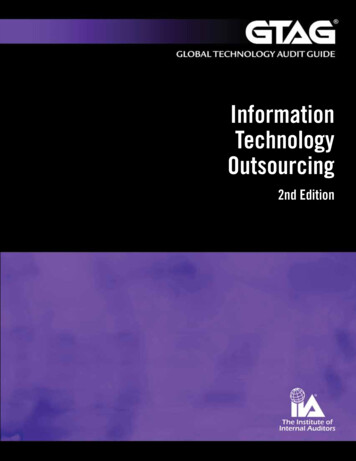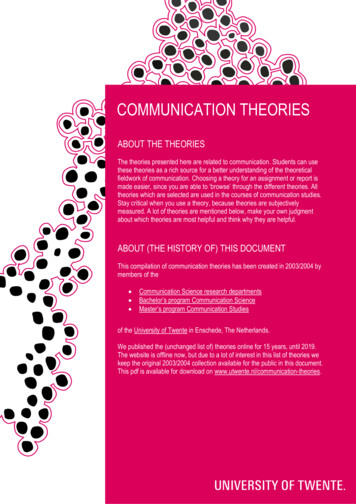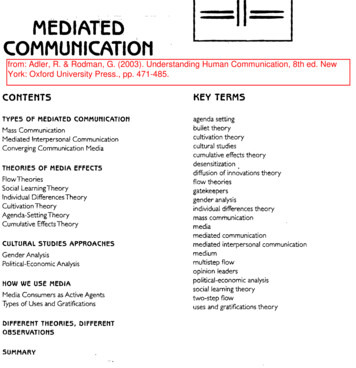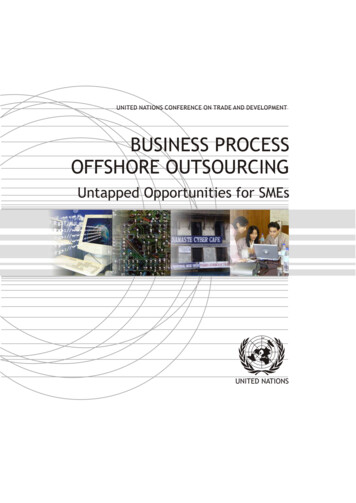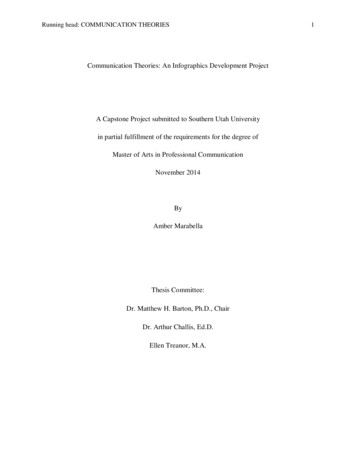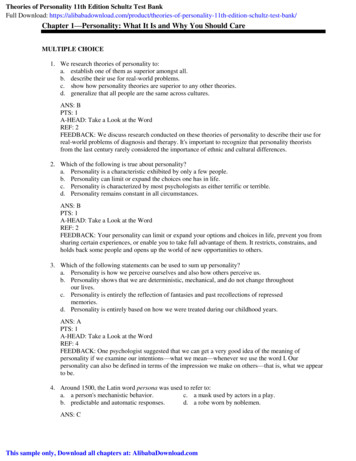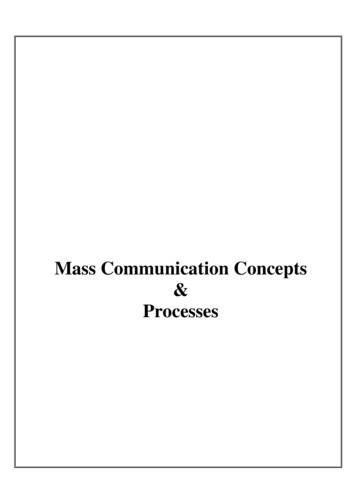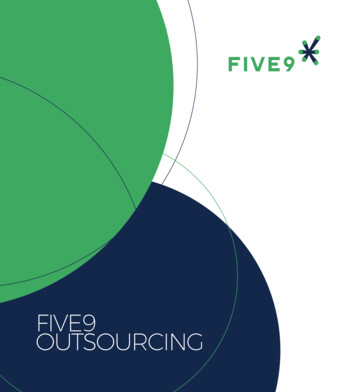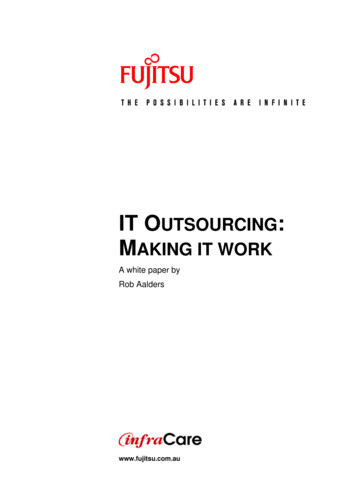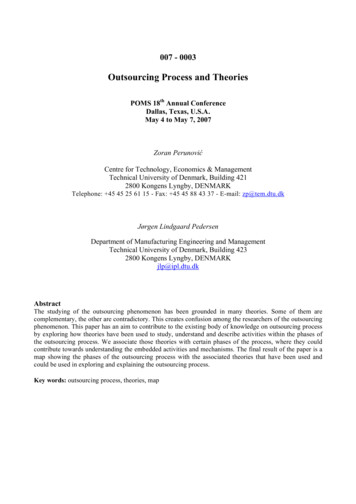
Transcription
007 - 0003Outsourcing Process and TheoriesPOMS 18th Annual ConferenceDallas, Texas, U.S.A.May 4 to May 7, 2007Zoran PerunovićCentre for Technology, Economics & ManagementTechnical University of Denmark, Building 4212800 Kongens Lyngby, DENMARKTelephone: 45 45 25 61 15 - Fax: 45 45 88 43 37 - E-mail: zp@tem.dtu.dkJørgen Lindgaard PedersenDepartment of Manufacturing Engineering and ManagementTechnical University of Denmark, Building 4232800 Kongens Lyngby, DENMARKjlp@ipl.dtu.dkAbstractThe studying of the outsourcing phenomenon has been grounded in many theories. Some of them arecomplementary, the other are contradictory. This creates confusion among the researchers of the outsourcingphenomenon. This paper has an aim to contribute to the existing body of knowledge on outsourcing processby exploring how theories have been used to study, understand and describe activities within the phases ofthe outsourcing process. We associate those theories with certain phases of the process, where they couldcontribute towards understanding the embedded activities and mechanisms. The final result of the paper is amap showing the phases of the outsourcing process with the associated theories that have been used andcould be used in exploring and explaining the outsourcing process.Key words: outsourcing process, theories, map
1. IntroductionThe outsourcing phenomenon has been increasingly receiving attention both from academic andpractitioners communities. The result of the research has lead towards the emergence of severalprocess frameworks depicting the phases of the outsourcing process. It is commonly recognised thatthe outsourcing process consists of the preparation, vendor(s) selection, transition, management ofrelationship, and reconsideration phases. Each of the phases has been broken down in the serious ofactivities that an outsourcing company performs.At the same time, the phases were subject to a flow of theoretical explanations. The studying of theoutsourcing phenomenon has been grounded in many theories. Some of them are complementary,the other are contradictory. This creates confusion among the researchers of the outsourcingphenomenon. This paper has an aim to contribute to the existing body of knowledge about theoutsourcing process by exploring how theories have been used to study, understand and describeactivities within the phases of the outsourcing process. In addition, we analyze the explanatorypower of various theories that haven’t been much used in studying the outsourcing. Consequentlywe associate those theories with certain phases of the process, where they could contribute towardsunderstanding the embedded activities and mechanisms. The final result of the paper is a mapshowing the phases of the outsourcing process with the associated theories that have been used andcould be used in exploring and explaining the outsourcing process.The paper is structured as follows. In the next section we describe the outsourcing processframework and enlist the key activities and issues embedded in each of the phases of the process. Inthe third section we present the literature study of the theories that have been used in the research onthe outsourcing process and provide a map associating the theories with the phases of the
outsourcing process. We conclude the paper with suggestions for the future potential utilization oftheories across the outsourcing process.2. Outsourcing processOutsourcing is the process of establishing and managing a contractual relationship with an externalsupplier for the provision of capacity that has previously been provided in-house (Momme, 2001).In spite of an impressive research intensity of the outsourcing process, there are only fewframeworks depicting the actual stages and the layout of the overall process of outsourcing. Figure1 presents an overview of some of the cImplicationsCompetenceAnalysisCullen and Willcocks(2003)Franceschini et al.(2003)Corbett(2004)Discardthe MythsPrepare theStrategiesIdeaDetermining theCurrent Boundary ofthe OrganisationCapabilityAnalysisSelect theSupplier(s)External BenchmarkingAnalysisAssessmentAnalysis of theStrategic Design lysisSelectingProvidersAssessmentand ApprovalTarget theServiceInternal BenchmarkingAnalysisClick and Duening(2005)McIvor(2005)Analysing Cost& PerfomanceDeveloping ioningResourcesManagingRelationshipProject Executionand TransferMake nagingRelationshipContractTerminationManage theOutsourcingReconsiderthe ansitionOperateEstablish, Manage andEvaluate AppropriateRelationshipFigure 1 - Overview of the outsourcing process frameworksAfter carefully examining the content of the stages of each of the proposed outsourcing processframeworks we have aligned the frameworks and grouped the stages into the following sequence:preparation, vendor(s) selection, transition, managing relationship and reconsideration (See Figure1). Each of the stages has to provide an answer on various questions, thus emphasising thecomplexity of the outsourcing process and arguing for a need that it has to be managed carefullythroughout all of its life cycle (See Figure 2). Cyclic and holistic characteristic of the outsourcing
process management is stemmed in the evolutionary economics (Nelson and Winter, 1982). Theevolutionary economic theory is in the core of process theories. It has received significantapplication in exploring firm’s learning characteristics for improving performance (Simonin, 1997),TIONcreating value (Anand and Khanna, 2000), and capabilities (Kale et al., 2002).ECONSIWhat?What now?Where?IOATRAREPPRDERAWhether?NSINATRGAGINMAN ONSHIPATIRELWhen?How?How?Whom to?NOTIVENDOR(S)SELECTIONFigure 2 – Framework for the process of outsourcing (Source: Perunovic et al., 2006)A more detailed insight into the contents of the phases is given in Table 1.PhasePreparationKey activitiesStrategySourcing optionsApproachConfigurationVendor(s) selectionScreening of potential vendorsPreferred relationshipPreferred length of the contractDrafting the SLAAnnouncing outsourcingChoosing the vendorNegotiatingFinalizing the contractTransitionDefining communication and exchange of knowledgeand informationTransferring assets, people, information, knowledge,hardware, softwareSome key issuesUnderlying philosophyWhy and what to outsourceBig BangIncrementalPiecemealMany suppliersPreferred suppliersPrime contractor with subcontractorsSole supplier (one stop shop)Contractual or collaborativeRFPEvaluationCreating a win-win situationType, flexibility and content of thecontractChange managementReengineeringAdopting organizational structure andprocesses
ManagingrelationshipHuman resource managementType of relationshipMaintaining relationshipHandling meetings and communicatingPerformance monitoring and evaluationApplying incentives and penaltiesSolving problemsRe-negotiating and managing variationsManaging success factorsReconsiderationReconsideringJob loss, transferReciprocalClient dominantVendor dominantPreferred vendorContractsTrustHostagesEconomic factorsCharacter of the exchangeCo-operation between buyer andsupplierDistance between buyer and supplierContinueChange vendorBacksourceSwitching costsTable 1 – Key activities and issues within the phases of the outsourcing process3. Theories in the Research of the Outsourcing ProcessThe outsourcing process is a complex structure consisting of numerous activities and subactivities,carrying many managerial dilemmas. It is no wonder that many theories have been utilized to helpthe academics to understand the nature of those activities, and to help practitioners successfullymanage the process. It is a common knowledge that each phenomenon can be described by severalframeworks that are embedded in various theoretical approaches. From its occurrence, theoutsourcing has been approached by different theories. This creates confusion among theresearchers of the outsourcing phenomenon. Various authors identified significant number oftheories that could explain the outsourcing phenomenon (cf. Gotttschalk and Solli-Sæther, 2005;McIvor, 2005).In order to depict the utilized theories we have conducted a literature study of the research papers inoutsourcing from the 1990 up to 2006. Table 2 shows the papers and the theories utilized. The lastcolumn indicates phases of the outsourcing process the paper and its theoretical grounding have
addressed. The abbreviations P, VS, T, MR, and R stand for the phases of the outsourcing processi.e., Preparation, Vendor(s) Selection, Transition, Managing relationship, and Reconsideration.YearAuthorsTheoryMethodKey ics (TCE)Case study1995PinningtonandWoolcockWillcocks andChoiCore competencesCase studyRelational viewCase study1995Willcocksal.Core competencesConceptualframework1996Aubert et al.TCE,Incompletecontract theoryCase study1996UlsetTCE, PropertytheoryrightsSurvey1997Brandes et al.TCE,competencesCoreCase encesCore rk of efficient governancestructures resulted in anomaliesGrowth of IT vendor industry iscreating a new firm relationship forthe IS functionDefining characteristics of total IToutsourcing strategic alliances andidentifying problems of managingthemFactorsaroundwhichIToutsourcing decisions can bebasedTCE and Incomplete contracttheory support the choice ofactivity to be outsourced andcontract management between theoutsorucer and its vendorWhen substantial externalities areinvolved, like in the supply of R&D,TCE should be combined withproperty rights theory to explaintheuseofgovernancemechanismsOutcomes are more successful ifoutsourcing decision is based oncorecompetenceandcostefficiency and if outsourced unit isable to develop strong resourcebaseFrameworkformakingtheoutsourcing decisionFrameworkformakingtheoutsourcing decisionFrameworkformakingtheoutsourcing decisionKnowledge sharing is positivelyrelated to outsourcing successPropositions regarding scope,speed and switching costs havebeen developedThe best predictor of success andfailure is the governance modeand the position of project in thevalue matrixFactors determining success fromoutsourcer’sandvendor’sperspective – goodprojectdefinition and specifications, petenceManagingoutsourcingbycontracts and trustUncertainty is major deterrent tooutsourcing, while the level oftechnical skills is the most199520002000et2001Baden-Fulleret d view,Core competencesEvolutionary economicsConceptualpaperRBVCase studyZviran et al.Relational viewCase study2003BarthélemyCase study2004Aubert et al.Agencytheory,Relational viewTCE,Incompletecontract theorySurveyApplicability tooutsourcingprocessP, VS, MR, RP,RP, MRPP, MRP, VS, MRP, MR, RPPPMRP, T, MR, RPP, VS, T, MR, RMRP
2005Barthélemyand emyand QuelinTCESurvey11 theoriesCase studyCore kjøttLarsenMiranda andKimMiraniCumulativetheory,TCE,Agency,Contracts, RBV, Corecompetences,Relational view, SocialexchangeTCE, Agency theory,Contracttheory,Relational viewTCE, Institutional theoryEvolutionary economicsConceptualframeworkWhitten andWakefieldTCE, 6TCE,viewResource-basedCase studySurveyimportant reason to outsourceDeterminants of outsourcing andquasi-outsourcing decisionsCorecompetencesandstakeholder theory explain bestcritical success factorsFrameworkformakingtheoutsourcing decisionTo restrict vendor’s opportunism,contracts must contain incentivesand penalties, as well as pricingand monitoring clausesMaturity model of IT outsourcingrelationshipsChallenges TCE, agency, andcontract theories and argues forrelational viewThe logic of TCE decision maker iscontingent on institutional contextStages of relationships arecontracts,networksandhierarchiesA second-order switching costsmodel for specifying switchingbehaviourPP, MR, RPP, VS, MR, RP, VS, T, MR, RP, VS, T, MRPMRRTable 2 – Theories utilized in the research of the outsourcing processThe research communicated in the selected papers (Table 2) was grounded in most of the cases inone or two theories. The exception is the work of Gottschalk and Solli-Sæther (2005, 2006) wherethe authors examine 11 theories in order to establish their explanatory power. The results suggestthat the theory of core competences, the stakeholder theory and the neoclassical economic theorybest explain the most important critical success factors of outsourcing relationships (corecompetence management, stakeholder management, and production cost reduction). In their laterwork (2006), the same authors apply cumulative theory to examine critical issues in stages ofmaturity in outsourcing relationship. They conclude that at the beginning of an outsourcingarrangement a Cost Stage occur, which is grounded in TCE and agency theory. After several yearsof having outsourcing the focus of the outsourcer shifts into the Resource Stage, where resourcebased view and core competences are the most important explanatory theories. At the end, the stageof Partnership may occur with the explanations sought in relational view, social exchange, and thestakeholders theory.
A content analysis of the selected research papers provides the distribution of the most utilizedtheories across the phases of the outsourcing process (Table 3). Letters in the cells indicate if atheory has been utilized to explore or explain some of the key activities and issues of a certainoutsourcing process’ phase in a large number of cases (L - more than 7), medium (M – between 4and 7 inclusive), or just a few (F – less than 3 nCost EconomicsLFRelational teContractsResource-basedviewAgency theoryKnowledgebased ViewNeoclassicaleconomictheorySocial exchangetheoryEconomics onsiderationMMMFFFFFFFFFFFFFFFFFFFFFFTable 3 – Utilized theories and phases of the outsourcing processTransaction Cost EconomicsTransaction cost economics (TCE) has been the most utilised theory of outsourcing. TCE isperceived to provide the best decision making tools to help organizations to decide to outsource andto prepare themselves for forthcoming outsourcing arrangements. The governance features of thetheory influenced that it has been applied in studying the Managing relationship phase, whilst theconcept of switching costs made the theory applicable in the reconsideration phase. Another usefulissue for outsourcing provided by TCE is explanation of contractual complexity. Though TCE hasnot been utilized explicitly for studying the Vendor selection phase, its sub-theory (if we may say
so), the theory of incomplete contracting, has been applied in studying the structure and contents ofoutsourcing contracts, and related preparation and contract management activities.Even though it has been exercised extensively in outsourcing applications, the TCE has severalindulgencies. Lacity and Willcocks (1995) found that the original mapping to the TCE frameworkonly explained few IT sourcing decisions and generated much more anomalies in their sample.Another critique could be that TCE relies on a single transaction as a unit of analysis, neglecting thecontemporary industrial collaborative arrangements. Finally, TCE is static, which doesn’tcorrespond to dynamism of current business environment.Relational ViewRelational view develops and explains how firms gain and sustain competitive advantage withininter-organisational relationships (McIvor, 2005). Its key premise – the concept of relational rentshas been explored to explain how firms choose their future outsourcing partners and preferred typeof the relationship. It has been also utilized in studying the Transition, Managing relationship andReconsideration phases. This makes the relational view to be the only theory that has been appliedin the research of all the outsourcing process’ phases.Concept of Core CompetencesThe concept of core competences has been developed on the basis of the resource-based theory.Prahalad and Hamel (1990) defined the core competencies as the collective learning in theorganisation, especially how to coordinate diverse production skills and integrate multiple streamstechnologies. The application of concept of core competences in outsourcing became very popularamong researchers. The concept has been predominantly use to develop and test variousoutsourcing decision frameworks arguing that the core activities shall remain in house. Learning
and communication premises of the concept made it also applicable in the Managing relationshipand Reconsideration phases. Vendor’s competences are assumed to be one of the most importantfactors that influence success of an outsourcing arrangement (Levina and Ross, 2003; Feeney et al.,2005).Resource-based ViewThe core premise of the resource-based view is that resources and capabilities can vary significantlyacross firms, and that these differences can be stable (Barney and Hesterly, 1996). If resources andcapabilities of a firm are mixed and deployed in a proper way they can create competitive advantagefor the firm. The resource-based view in outsourcing builds from a proposition that an organisationthat lacks valuable, rare, inimitable and organised resources and capabilities, shall seek for anexternal provider in order to overcome that weakness. Therefore the most prominent use of thetheory is in the Preparation phase of the outsourcing process for defining the decision makingframework and in the vendor selection phase for selecting an appropriate vendor. The theory hasbeen also used to explain some of the key issues of the Managing relationship and Reconsiderationphases.Evolutionary EconomicsAlthough mentioned for the first time in the 19th century, the evolutionary economics experiencedrevival after Nelson and Winter’s work in 1982. The theory develops from Darwinism and includessome assumptions transposed to the economic “species”. These assumptions include (Andersen,1994): The agents (individuals and organisations) can never be perfectly informed and they have tooptimize locally rather than globally The decision-making of agents is normally bound to rules, norms and institutions
Agents are to some extent able to imitate the rules of other agents, to learn for themselvesand to create novelty, The processes of imitation and innovation are characterised by significant degrees ofcumulativeness and path dependency but they may be interrupted by occasionaldiscontinuities The interaction between the agents are typically made in disequilibrium situations and theresult is success and failures of commodity variants and method variants as well as agents The processes of change occurring in a context described by the above assumptions andcharacteristics are non-deterministic, open-ended and irreversible.This makes the theory highly applicable in outsourcing. However, the actual research has been verymodest studying issues predominantly within the Managing relationship phase. The other phases ofthe outsourcing process (expect the transition) have been also explored through the evolutionaryeconomics but very scarcely.Agency TheoryThe focus of the agency theory originally was on the relationship between managers andstakeholders (Jensen and Meckling, 1976), but had spread over the time on explaining therelationship between two inter-firm subjects. In that context we associate the agency theory tounderstanding the relationship between outsourcer and vendor. Sources of the agency problem,moral hazards and adverse selection (Arrow, 1985) are should be resolved by monitoring andbonding (Barney and Hesterly, 1996). Consequently, the application of the theory in the outsourcingprocess research was in the Preparation Phase (when screening for vendors and defining its ownattitude towards the type of the relationship. Naturally, the Managing relationship phase has beenalso explored, and to a very small extent the Reconsideration phase.
Knowledge-based ViewThe knowledge-based view provides insight in understanding how individuals co-operate toproduce goods and services. The knowledge-based view distinguishes two ways how knowledge isshared among partners. They are knowledge generation and knowledge application. Theknowledge-based view has been used in utilized in the outsourcing research to prove thatknowledge sharing in the Managing relationship phase is positively related to the success of anoutsourcing arrangement.Neoclassical Economic TheoryThe key characteristics of the neoclassical economic theory are (Hodgson, 1994): Assumption of rational, maximizing behaviour by agents with given preference function Focus on attained, or movement towards, equilibrium states Absence of chronic information problemThe neoclassical theory explains the initial motives for outsourcing demonstrated by somepioneering companies like Kodak. However, the theory has received a significant critique for notbeing able to explain contemporary business processes. Especially, the concepts of rationality andabsence of chronic information problem have been criticised. However Gottschalk and Solli-Sæther(2005) showed that the neoclassical economic theory explains critical success factors of outsorucingthat are being evaluated in the Reconsideration phase.Social Exchange TheoryThe social exchange theory explains interpersonal relationships by positing the economical costbenefit analysis as precondition for social engagement and exchange. The theory presupposes thatthe exchange of resources (material or social) is a basic form of human interaction. Social exchangeis an ongoing reciprocal process in which actions are contingent on rewarding reactions from others
(Gottschalk and Solli-Sæther, 2005). The theory has been used in combination with TCE tospecifying switching behaviour in the Reconsideration phase.Economy of InformationIt has been admitted that the information is not perfect and new economical models emerged toexplain situations where two parties possess unequal or none quantity of information. One of thefirst works in the area was development of the search theory (Stigler, 1961). The identification ofsellers and the discovery of their prices are only one sample of the vast role of the search forinformation in economic. Another key concept of the economy of information is the concept ofsignalling developed by Spence (1973). His essay is about markets in which signalling takes placeand in which the primary signallers are relatively numerous and in the market sufficientlyinfrequently that they are not expected to invest in acquiring signalling reputation. Application ofthe economy of information in outsourcing is associated to activities of searching, selecting, andcontracting the vendor. However, the economics of information hasn’t been used explicitly in thestudies of the outsourcing process.4. ConclusionIn most theories about outsourcing processes the perspective has been focused on exploring certainissues emerging within the phases of the process. The problem occurring in such approach is tochoose between many different possible outcomes. In principle it is possible to find an optimalsolution of this rather stationary problem.However a more fruitful and practically useful approach could be taken if we ask questions aboutthe dynamics in the outsourcing processes. What is important in such cases can be caught up underthe term learning. The idea is that the outsourcing decision makers will take into account results of
former decisions in similar cases. This creates a need to study the outsourcing process as anevolutionary process. Evolutionary thinking in economics and more generally in social sciences asorganizational theory and sociology has used these insights to draw one important conclusionnamely that structure is not sufficiently to make an optimal solution in outsourcing considerations.It is also necessary to take into consideration the actors with their interpretation of history. In socialsciences the problematic is well known as the structure – actor problem.Applied to the outsourcing problematic the point is that the relevant discussion is not only to look atthe mention theoretical models or explanations of the outsourcing phenomenon. It is also aboutdoing matters in another way next time because you have some mistakes and failures done firsttime. Therefore we cannot draw a conclusion about the absolute optimal solution in beforehand. Wecan and shall learn from history but still at one point we shall stop and make a decision.References1. Andersen E.S., (1994). Evolutionary Economics, Post-Schumpeterian Contributions, Pinter,London2. Arnold U., (2000). “New dimensions of outsourcing: a combination of transaction costeconomics and the core competencies concept”, European Journal of Purchasing & SupplyManagement, 6, pp. 23-293. Arrow K.J., (1985). “The economics of agency”, in Principals and Agents: the Structure ofAmerican Business, Harvard Business School Press, Boston4. Aubert B.A., Rivard S., Patry M., (1996). “A transaction cost approach to outsourcingbehaviour: Some empirical evidence”, Information and Management, 30, pp. 51-645. Aubert B.A., Rivard S., Patry M., (2004). “A transaction cost models of IT outsourcing”,Information & Management, 41, pp. 921-932
6. Baden-Fuller C., Targett D., Hunt B., (2000). ”Outsourcing to Outmanoeuvre: OutsourcingRedefines Competitive Strategy and Structure”, European Management Journal, 18, 3, pp.285-2957. Barney J.B., Hesterly W., (1996). “Organizational Economics: Understanding theRelationship between Organizations and Economic Analysis”, in Clegg S.R., Hardy C.,Nord W.R. (Eds.) Handbook of Organization Studies, Sage Publications, London8. Barthélemy J., (2003). ”The Hard and Soft Sides of IT Outsourcing Management”,European Management Journal, 21, 5, pp. 539-5489. Barthélemy J., Geyer D., (2005).”An empirical investigation of IT outsourcing versus quasioutsourcing in France and Germany”, Information & Management, 42, 4, pp. 533-54210. Brandes H., Lilliecreutz J., Brege S., (1997). ”Outsourcing-success or failure?”, EuropeanJournal of Purchasing & Supply Management, 3, 2, pp. 63-7511. Click R.L., Duening T.N. (2005). Business Process Outsourcing: The CompetitiveAdvantage, John Wiley & Sons, Hoboken12. Corbett M.F., (2004). The outsourcing revolution: Why it makes sense and how to do itright, Dearborn Trade Publishing, Chicago13. Cullen S., Willcocks L., (2003). Intelligent IT Outsourcing: Eight Building Blocks toSuccess, Butterworth-Heinemann, Oxford14. Feeny D., Lacity M., Willcocks L., (2005). “Taking the measure of outsourcing providers”,MIT Sloan Management Review, 46, 3, pp. 41-4815. Franceschini F., Galetto M., Pignatelli A., Varetto M., (2003). “Outsourcing: guidelines fora structured approach”, International Journal of Benchmarking, 10, 3, pp. 246-26016. Gottschalk P., Solli-Sæther H. (2005). “Critical success factors from IT outsourcingtheories: an empirical study”, Industrial Management & Data Systems, 105, 6, pp. 685-702
17. Gottschalk P., Solli-Sæther H. (2006). “Maturity model for IT outsourcing relationships”,Industrial Management & Data Systems, 106, 2, pp. 200-21218. Greaver M.F., (1999). Strategic Outsourcing: A Structured Approach to OutsourcingDecisions and Initiatives, AMACOM, New York19. Halldórsson Á., Skjøtt-Larsen T., (2006). “Dynamics of relationship governance in TPLarrangements – a dyadic perspective”, International Journal of Physical Distribution andLogistics Management, 36, 7, pp. 490-50620. Hodgson G.M., (1994). “Critique of Neoclassical Microeconomic Theory”, in HodgsonG.M., Samuels W.J., Tool M.R., The Elgar Companion to Institutional and EvolutionaryEconomics, Edward Elgar, Aldershot21. Jensen M.C., Meckling W.H., (1976). “Theory of the firm: managerial behaviour, agencycosts and ownership structure”, Journal of Financial Economics, 3, pp. 305-36022. Lacity M., Willcocks L., (1995). “Interpreting Information Technology Sourcing Decisionsfrom a Transaction Cost Perspective: Findings and Critique”, Accounting, Management andInformation Technology, 5, 3/4, pp. 204-24423. Levina N., Ross J.W., (2003). “From the Vendor’s Perspective: Exploring the ValueProposition in Information Technology Outsourcing”, MIS Quarterly, 27, 3, pp. 331-36424. Mahnke V., (2001). “The Process of Vertical Dis-Integration: An Evolutionary Perspectiveon Outsourcing”, Journal of Management and Governance, 5, pp. 353-37925. McIvor R., (2005). The Outsourcing Process, Cambridge, Cambridge26. Miranda S.M., Kim Y-M., (20069. ”Professional versus political contexts: Institutionalmitigation and the transaction cost heuristic in infomration systems outsourcing”, MISQuarterly, 30, 3, pp. 725-75327. Mirani R., (2006). “Client-Vendor Relationships in Offshore Applications Development: AnEvolutionary Framework”, Information Resources Management Journal, 19, 4, pp. 72-86
28. Momme J. (2001). Outsourcing Manufacturing to Suppliers, PhD dissertation, Departmentof Production Aalbrog University, Aalborg29. Momme J., (2002). “Framework for outsourcing manufacturing: strategic and operationalimplications”, Computers in Industry, 49, pp. 59-7530. Nelson R.R., Winter S.G. (1982). An evolutionary theory of economic chan
Outsourcing Process and Theories POMS 18th Annual Conference Dallas, Texas, U.S.A. May 4 to May 7, 2007 Zoran Perunović Centre for Technology, Economics & Management Technical University of Denmark, Building 421 2800 Kongens Lyngby, DENMARK Telephone: 45 45 25 61 15 - Fax: 45 45 8
